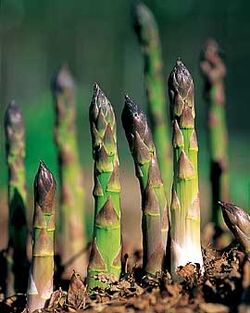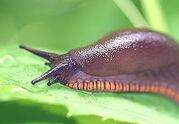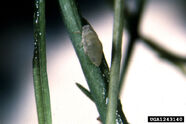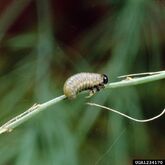| Asparagus | |
|---|---|
 |
|
| Scientific Classification | |
| Kingdom: | Plantae |
| (Unranked): | Angiosperms |
| (Unranked): | Monocots |
| Order: | Asparagales |
| Family: | Asparagaceae |
| Genus: | Asparagus |
| Species: | Asparagus officinalis |
| Plant Data | |
|---|---|
| Min germination temp: | 21°C (70°F) |
| Max germination temp: | 26°C (79°F) |
| Germination time: | 18 days |
| Time to transplanting: | +53 days |
| Time to harvesting: | +32 days |
| Mature height: | 25cm (10in) |
| Mature spread: | 45cm (17½in) |
| Ideal pH range: | 7.0 |
| Sow depth: | 5cm (2in) |
| References: | [1][2] |
Asparagus (Asparagus officinalis) is a spring vegetable. A flowering perennial[3] plant species in the genus Asparagus, like its allium cousins, onions and garlic, it is native to most of Europe, northern Africa and western Asia.[4][5] and is widely cultivated as a vegetable crop.
Planner[]
| J | F | M | A | M | J | J | A | S | O | N | D | |||||||||||||
| Sow Time | ||||||||||||||||||||||||
| Planting Time | ||||||||||||||||||||||||
| Cutting Time | ||||||||||||||||||||||||
Growing[]
Location[]
Pick a sunny spot, sheltered from strong winds with good drainage.[2]
Soil[]
Soil type is not too important. Dig through in autumn incorporating plenty of well-rotted manure or compost. Liming will be necessary if soil is very acidic. Remove the roots of perennial while digging, leaving soil rough. Fork over in March and apply a general fertiliser.[2]
Planting crowns[]
Dig a trench 20cm (8in) deep and 30cm (12in) wide. Leave a 8cm (3in) ridge in the bottom of the trench and place the crowns on the ridge with roots spread outwards. Cover immediately with 5cm (2in) of sifted soil. Fill in gradually as the plants grow, it should be level by autumn.[2]
Aftercare[]
Shortly after planting the first spears should appear. These should not be cut, but should be left to develop into bushy fern-like stems. The year after planting little or no cutting should take place. It may be possible to remove one spear per plant in May.[2]
Weed the bed regularly. Provide support for stems if necessary. Water during dry weather. Pick berries before they fall to the ground.[2]
In autumn cut down the ferny stems once they have turned yellow. The stumps should be 2-5cm (1-2in) above the surface.[2]
Before the spears appear in spring make a ridge of soil over each row. Apply a surface dressing of general fertiliser.[2]
Harvesting[]
Cutting can begin in the second year after planting. Once a spear reaches 10-13cm (4-5in) they should be cut 7-8cm (3in) below the soil surface. Use a serrated kitchen knife or special asparagus knife. Cut daily if necessary, but never let the spears get too tall before cutting.[2]
Stop cutting in early-mid June. All spears must now be allowed to develop into fern in order to build up for next year's crop.[2]
Troubles[]
- Full troubles list: Asparagus troubles
References[]
- ↑ (2010). Asparagus. myfolia. Retrieved: 2010-07-31.
- ↑ a b c d e f g h i j Hessayon, D.G. (2009). The Vegetable & Herb Expert. Transworld Publishers, London. p. 10. ISBN 9780903505468
- ↑ Grubben, G.J.H.; Denton, O.A., eds (2004). Plant Resources of Tropical Africa 2. Vegetables. PROTA Foundation, Wageningen; Backhuys, Leiden; CTA, Wageningen.
- ↑ Asparagus officinalis. Flora Europaea. Royal Botanic Garden Edinburgh. Retrieved 2010-05-19.
- ↑ USDA, ARS, National Genetic Resources Program. Asparagus officinalis. Germplasm Resources Information Network. Beltsville, Maryland: National Germplasm Resources Laboratory. Retrieved 2010-05-19.
| This page uses Creative Commons Licensed content from Wikipedia (view authors). |




